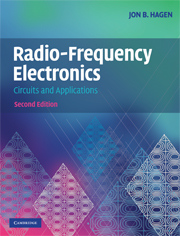Book contents
- Frontmatter
- Contents
- Preface
- 1 Introduction
- 2 Impedance matching
- 3 Linear power amplifiers
- 4 Basic filters
- 5 Frequency converters
- 6 Amplitude and frequency modulation
- 7 Radio receivers
- 8 Suppressed-carrier AM and quadrature AM (QAM)
- 9 Class-C, D, and E Power RF amplifiers
- 10 Transmission lines
- 11 Oscillators
- 12 Phase lock loops and synthesizers
- 13 Coupled-resonator bandpass filters
- 14 Transformers and baluns
- 15 Hybrid couplers
- 16 Waveguide circuits
- 17 Small-signal RF amplifiers
- 18 Demodulators and detectors
- 19 Television systems
- 20 Antennas and radio wave propagation
- 21 Radar
- 22 Digital modulation techniques
- 23 Modulation, noise, and information
- 24 Amplifier and oscillator noise analysis
- 25 The GPS Navigation system
- 26 Radio and radar astronomy
- 27 Radio spectrometry
- 28 S-parameter circuit analysis
- 29 Power supplies
- 30 RF test equipment
- Index
- References
15 - Hybrid couplers
Published online by Cambridge University Press: 05 June 2012
- Frontmatter
- Contents
- Preface
- 1 Introduction
- 2 Impedance matching
- 3 Linear power amplifiers
- 4 Basic filters
- 5 Frequency converters
- 6 Amplitude and frequency modulation
- 7 Radio receivers
- 8 Suppressed-carrier AM and quadrature AM (QAM)
- 9 Class-C, D, and E Power RF amplifiers
- 10 Transmission lines
- 11 Oscillators
- 12 Phase lock loops and synthesizers
- 13 Coupled-resonator bandpass filters
- 14 Transformers and baluns
- 15 Hybrid couplers
- 16 Waveguide circuits
- 17 Small-signal RF amplifiers
- 18 Demodulators and detectors
- 19 Television systems
- 20 Antennas and radio wave propagation
- 21 Radar
- 22 Digital modulation techniques
- 23 Modulation, noise, and information
- 24 Amplifier and oscillator noise analysis
- 25 The GPS Navigation system
- 26 Radio and radar astronomy
- 27 Radio spectrometry
- 28 S-parameter circuit analysis
- 29 Power supplies
- 30 RF test equipment
- Index
- References
Summary
Hybrid couplers, also known as hybrid junctions or simply “hybrids,” are lossless passive four-port devices used to make interconnections between circuit elements. Hybrids are used as power dividers (“signal splitters”) and combiners. They are also used in mixers and TR (transmit/receive) switches. A useful schematic representation for a hybrid,Figure 15.1, shows the four connection points (ports).
RF hybrids usually have unbalanced ports designed for coaxial transmission lines, so all four ports share a common ground, indicated in Figure 15.1 by a dotted ground symbol (usually not shown). Each port has a characteristic impedance. Most packaged RF hybrids with coaxial ports are made so that the characteristic impedance of all four ports is 50 or 75 ohms. The symbol in Figure 15.1 shows signal flow paths; power incident on Port 1 splits and exits through Ports 2 and 3. If both of these ports are properly terminated there will be no reflections and the impedance seen looking into Port 1 will be equal to the characteristic impedance of that port. In this case no power will reach Port 4 as opposite ports are isolated. But if Port 2 and/or Port 3 are not terminated in their own characteristic impedances, the power exiting these ports will be partially or completely reflected back into the hybrid. The reflection, which depends on the mismatch, is calculated exactly as if the power had exited from a transmission line whose impedance is equal to that of the respective port.
- Type
- Chapter
- Information
- Radio-Frequency ElectronicsCircuits and Applications, pp. 181 - 194Publisher: Cambridge University PressPrint publication year: 2009
References
- 1
- Cited by



